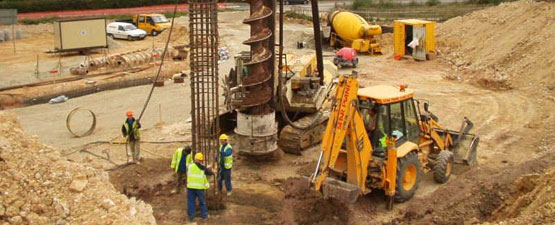The Interdisciplinary Approaches in the Geotechnical Sector: Linking the Void Between Engineering, Geology, and Environmental Science for Ideal Project End Results
The integration of engineering, geology, and environmental scientific research within the geotechnical market is not simply useful; it is essential for attaining ideal job outcomes. This interdisciplinary cooperation cultivates a comprehensive understanding of complex website conditions, permitting innovative services to arise. By analyzing key duties and effective study, we can uncover the vibrant interaction that drives task success. However, obstacles continue to be in efficiently handling these multidisciplinary efforts, questioning regarding prospective innovations and future patterns. What strategies might arise to promote this important cooperation and improve the effectiveness of geotechnical techniques?
Importance of Interdisciplinary Partnership
The relevance of interdisciplinary partnership in the geotechnical industry can not be overstated. Efficient geotechnical jobs require the assimilation of varied competence from numerous fields, consisting of engineering, geology, and ecological scientific research. This partnership makes certain that all elements of a job are considered, resulting in thorough remedies that deal with intricate obstacles.
Interdisciplinary partnership fosters advancement by allowing experts to share insights and methodologies that may not appear when working in isolation (consulting engineer). By leveraging the toughness of several techniques, groups can identify potential threats, optimize layout processes, and enhance the sustainability of geotechnical tasks. Moreover, such partnership advertises an all natural understanding of site-specific conditions, which is vital for precise analysis and decision-making.
The complexity of geotechnical jobs demands a coordinated technique to analytic. Ultimately, interdisciplinary cooperation is crucial for advancing best methods and accomplishing quality in the geotechnical sector.
Key Roles of Each Technique
Partnership among different techniques is not just helpful; it is crucial for the successful implementation of geotechnical tasks. Each technique-- engineering, geology, and environmental scientific research-- plays a distinctive yet interconnected function that adds to project efficacy and sustainability.
Geotechnical engineers are primarily liable for developing foundations and making certain architectural integrity. They evaluate dirt and rock residential or commercial properties to evaluate load-bearing capacities, offering necessary data for secure construction practices. Their know-how enables the formula of cutting-edge solutions to complicated obstacles.

Ecological scientists assess the potential effects of construction on ecological communities and water resources. They perform environmental evaluations and create reduction approaches to minimize unfavorable results. By integrating eco-friendly considerations, they make certain compliance with guidelines and promote sustainability throughout the project lifecycle.
Study of Successful Combination
Successful combination of geotechnical techniques can be exemplified via various situation studies that highlight the performance of synergy in resolving complex engineering challenges. One noteworthy example is the construction of the Hong Kong-- Zhuhai-- Macau Bridge, where a joint technique entailing geotechnical engineering, geology, and environmental science was crucial. Engineers and rock hounds worked in unison to evaluate the seabed conditions and enhance the structure layout, ensuring stability and reducing environmental impact.
Another impactful instance is the enhancement of incline security in the San Francisco Bay Area, where an interdisciplinary team incorporated geotechnical evaluation with environmental analyses. By incorporating hydrological studies and geological studies, the team successfully recognized possible landslide risks and applied effective reduction actions, enhancing safety and security and sustainability.
Additionally, the redevelopment of Brownfield sites commonly needs a multidisciplinary approach. In one case in Chicago, cooperation among geotechnical engineers, ecological scientists, and city coordinators led to the effective removal of contaminated dirt, permitting the safe improvement of the website into a community park. These study illustrate that interdisciplinary collaboration not only addresses technological obstacles but additionally cultivates ingenious options that benefit both communities and jobs.
Difficulties in Multidisciplinary Projects

In addition, coordinating timetables and operations amongst different groups can be bothersome, specifically when each discipline has unique job turning points and deliverables. This misalignment can cause hold-ups and increased costs. The difficulty of resource allotment also impends large; guaranteeing that specific experience is readily available at critical times calls for cautious planning and foresight.
Finally, regulative conformity positions another considerable difficulty. Each technique may encounter different regulatory structures, and aligning these demands to meet job objectives can be websites taxing and intricate. Addressing these difficulties necessitates solid management and effective interaction approaches to cultivate cooperation and guarantee that multidisciplinary teams work cohesively towards shared goals.
Future Trends in Geotechnical Practices
As the geotechnical sector evolves, arising trends are improving techniques to address the obstacles encountered in multidisciplinary projects - consulting engineer. One substantial fad is the enhanced combination of advanced technologies, such as expert system and artificial intelligence, right into geotechnical evaluation and design. These innovations improve predictive modeling and danger assessment, navigate to this website allowing designers to make even more educated choices throughout the task lifecycle

Additionally, the adoption of electronic doubles and real-time surveillance systems is becoming much more widespread. These devices help with ongoing assessment of soil problems and structural performance, permitting timely interventions when concerns occur.
Verdict
Finally, the integration of design, geology, and environmental scientific research is crucial for attaining optimum end results in the geotechnical market. Interdisciplinary partnership promotes technology, enhances analytic abilities, and straightens technical demands with ecological sustainability. Effective instance researches highlight the benefits of this technique, while acknowledging the challenges encountered in multidisciplinary projects. Looking in advance, accepting these joint techniques will certainly be essential for browsing future patterns and progressing the field of geotechnical design.
The assimilation of design, geology, and environmental science within the geotechnical sector is not merely useful; it is essential for accomplishing ideal project end results. Effective geotechnical projects call for the combination read more of varied proficiency from different areas, including design, geology, and environmental scientific research.Browsing the complexities of multidisciplinary jobs in the geotechnical market presents a number of substantial challenges.As the geotechnical market progresses, arising fads are improving methods to address the challenges dealt with in multidisciplinary jobs. Geotechnical engineers are progressively teaming up with environmental scientists to make sure that projects straighten with sustainability objectives and comply with governing requirements.
Comments on “The Benefits of Partnering with a Leading Consulting Engineer for Your Organization Needs”